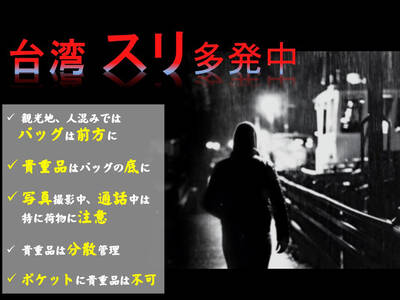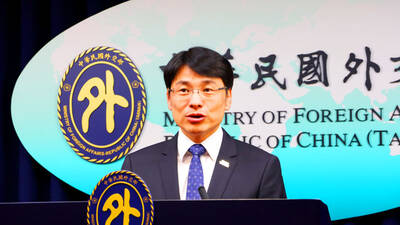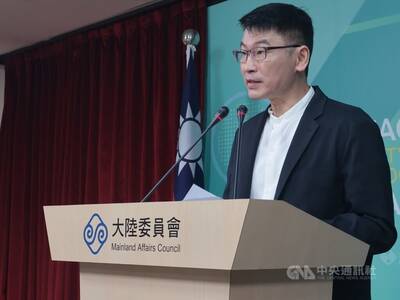A representative of the Mikura community in Kobe, Japan, signed an agreement on Monday in Taipei to permit the reconstruction of an antique Japanese-style building in Tamsui (淡水).
The Mikura community’s Hozan Tanaka attended the signing ceremony, which will see an antique wooden building — said to have been assembled only with mortise and tenon joints, using no nails — rebuilt in Tamsui Township.
The historic building was constructed in 1915 in Japan’s Fukui Prefecture by the father of Tsutomu Minakami, a popular and prolific Japanese author.
Tanaka lamented the fact that Minakami, who died in September 2004, had not lived to see the new structure.
The plan to rebuild the structure in Taiwan came after many twists and turns.
A couple in Fukui Prefecture, on Japan’s west coast, learned of the prefecture’s plan to tear down the antique building to make way for a park.
They first suggested that the local government donate the building to Kobe’s Mikura community and have it rebuilt there, because of the community’s experience reconstructing an antique 1870 residence after it was damaged in a powerful earthquake in 1995.
However, the Mikura community decided it wanted to rebuild the structure in Taiwan to show their compassion for victims of the 921 Earthquake. In late 1999 community residents had visited areas affected by that disaster.
The rebuilt structure will hold 200 books by Minakami, according to the initial plan by the Tamsui Township Office.
The office said it also plans to set up an exhibition zone to showcase the works of Chen Shun-chen (陳舜臣), a Taiwanese author born in Kobe who settled in Tamsui after moving back from Japan in 1999.
Tanaka said that Japan was happy to see the project move forward, since it had been stalled for four years by Taiwan’s complex building codes. In May, the construction project was finally grouped into the category of “memorial architecture,” which would allow construction to go forward without the need for a building license.
Local architect Chiu Ming-min’s (邱明民) work over the last four years was critical for gaining approval from the Taipei County Government.
Chiu said that the Japanese community in Kobe agreed to have the wooden structure rebuilt in August 2004.
He and film director Chuang Yue (莊岳) then led four architecture students on a trip to Fukui Prefecture, where they spent four weeks dismantling the wooden building and coding the parts.
Thirty Japanese volunteer architects helped them with the work. Many of them promised to come to Taiwan to help rebuild the structure, Chiu said.
In 2005, Chiu transported about 500 dismantled wooden pieces in shipping containers to Taiwan, where they were stored at a cultural foundation.
Tamsui Township Mayor Tsai Yeh-wei (蔡葉偉) said that gaining approval for the project had not been easy, because of legal restrictions on building wooden structures in Taiwan.
The wooden building will be listed in a group of historical structures in Tamsui that includes originally Dutch, Spanish and British-built landmarks.
The township will also construct a “peace park” near the wooden building to symbolize the friendship between Taiwan and Japan, Tsai said.
Japan’s help with the reconstruction project was a sign of the friendship and peace between the two countries, which have strong historical ties, he said.

The Japan-Taiwan Exchange Association has cautioned Japanese travelers to be vigilant against pickpockets at several popular tourist spots in Taiwan, including Taipei’s night markets, the Yongkang Street area, Zhongshan MRT Station, and Jiufen (九份) in New Taipei City. The advisory, titled “Recent Development of Concerns,” was posted on the association’s Web site under its safety and emergency report section. It urges travelers to keep backpacks fully zipped and carried in front, with valuables placed at the bottom of the bag. Visitors are advised to be especially mindful of their belongings when taking photos or speaking on the phone, avoid storing wallets and

ENDORSING TAIWAN: Honduran presidential candidate Nasry Afura said that Honduras was ‘100 times better off’ when it was allied with Taipei The Ministry of Foreign Affairs yesterday said it would explore the possibility of restoring diplomatic relations with Honduras based on the principle of maintaining national interests and dignity. The ministry made the remarks in response to reporters’ questions regarding an article titled: “Will Taiwan Regain a Diplomatic Ally?” published in The Diplomat on Saturday. The article said Honduras’ presidential election in November could offer Taiwan the chance to regain an ally, as multiple candidates have promoted re-establishing diplomatic relations with Taiwan. Honduras severed diplomatic ties with Taiwan in March 2023 in favor of Beijing, but since switching its diplomatic recognition,

Scoot announced yesterday that starting in October, it would increase flights between Taipei and Japan’s Narita airport and Hokkaido, and between Singapore and Taipei. The low-cost airline, a subsidiary of Singapore Airlines, also said it would launch flights to Chiang Rai in Thailand, Okinawa and Tokyo’s Haneda airport between December and March next year. Flights between Singapore and Chiang Rai would begin on Jan. 1, with five flights per week operated by an Embraer E190-E2 aircraft, Scoot said. Flights between Singapore and Okinawa would begin on Dec. 15, with three flights per week operated by Airbus A320 aircraft, the airline said. Services between Singapore

The Mainland Affairs Council (MAC) yesterday announced a ban on all current and former government officials from traveling to China to attend a military parade on Sept. 3, which Beijing is to hold to mark the 80th anniversary of the end of the Second Sino-Japanese War. "This year marks the 80th anniversary of the end of World War II and the Republic of China’s victory in the War of Resistance [Against Japan]," MAC Deputy Minister and spokesperson Liang Wen-chieh (梁文傑) told a regular news briefing in Taipei. To prevent Beijing from using the Sept. 3 military parade and related events for "united